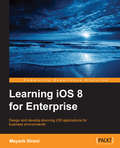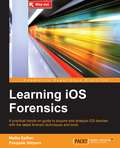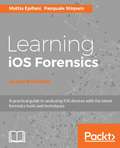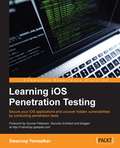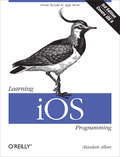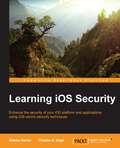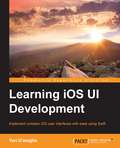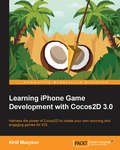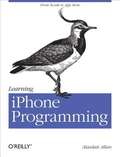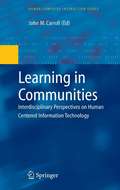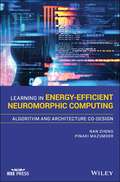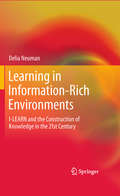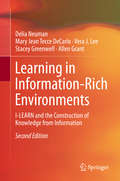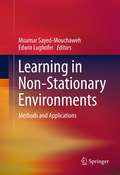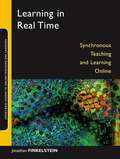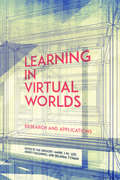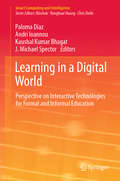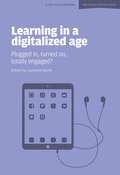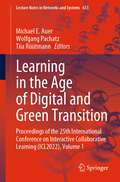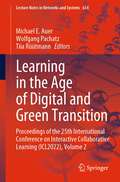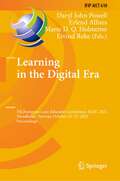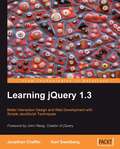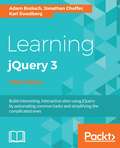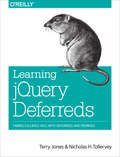- Table View
- List View
Learning iOS 8 for Enterprise
by Mayank BiraniIf you are an experienced iPhone application developer or even a newbie, this book will help you to build on and explore your technical skills. This book is very helpful for those who want to learn about the new framework of iOS 7 and iOS 8.
Learning iOS Forensics
by Pasquale Stirparo Mattia EpifaniIf you are a digital forensics examiner daily involved in the acquisition and analysis of mobile devices and want to have a complete overview of how to perform your work on iOS devices, this book is definitely for you.
Learning iOS Forensics - Second Edition
by Pasquale Stirparo Mattia EpifaniA practical guide to analyzing iOS devices with the latest forensics tools and techniques About This Book * This book is a comprehensive update to Learning iOS Forensics * This practical book will not only cover the critical aspects of digital forensics, but also mobile forensics * Whether you're a forensic analyst or an iOS developer, there's something in this book for you * The authors, Mattia Epifani and Pasquale Stirparo, are respected members of the community, they go into extensive detail to cover critical topics Who This Book Is For The book is for digital forensics analysts, incident response analysts, IT security experts, and malware analysts. It would be beneficial if you have basic knowledge of forensics What You Will Learn * Identify an iOS device between various models (iPhone, iPad, iPod Touch) and verify the iOS version installed * Crack or bypass the protection passcode chosen by the user * Acquire, at the most detailed level, the content of an iOS Device (physical, advanced logical, or logical) * Recover information from a local backup and eventually crack the backup password * Download back-up information stored on iCloud * Analyze system, user, and third-party information from a device, a backup, or iCloud * Examine malicious apps to identify data and credential thefts In Detail Mobile forensics is used within many different domains, but is chiefly employed in the field of information security. By understanding common attack vectors and vulnerability points, security professionals can develop measures and examine system architectures to harden security on iOS devices. This book is a complete manual on the identification, acquisition, and analysis of iOS devices, updated to iOS 8 and 9. You will learn by doing, with various case studies. The book covers different devices, operating system, and apps. There is a completely renewed section on third-party apps with a detailed analysis of the most interesting artifacts. By investigating compromised devices, you can work out the identity of the attacker, as well as what was taken, when, why, where, and how the attack was conducted. Also you will learn in detail about data security and application security that can assist forensics investigators and application developers. It will take hands-on approach to solve complex problems of digital forensics as well as mobile forensics. Style and approach This book provides a step-by-step approach that will guide you through one topic at a time. This intuitive guide focuses on one key topic at a time. Building upon the acquired knowledge in each chapter, we will connect the fundamental theory and practical tips by illustrative visualizations and hands-on code examples.
Learning iOS Penetration Testing
by Swaroop YermalkarSecure your iOS applications and uncover hidden vulnerabilities by conducting penetration testsAbout This BookAchieve your goal to secure iOS devices and applications with the help of this fast paced manualFind vulnerabilities in your iOS applications and fix them with the help of this example-driven guideAcquire the key skills that will easily help you to perform iOS exploitation and forensics with greater confidence and a stronger understandingWho This Book Is ForThis book is for IT security professionals who want to conduct security testing of applications. This book will give you exposure to diverse tools to perform penetration testing. This book will also appeal to iOS developers who would like to secure their applications, as well as security professionals. It is easy to follow for anyone without experience of iOS pentesting.What You Will LearnUnderstand the basics of iOS app development, deployment, security architecture, application signing, application sandboxing, and OWASP TOP 10 for mobileSet up your lab for iOS app pentesting and identify sensitive information stored locallyPerform traffic analysis of iOS devices and catch sensitive data being leaked by side channelsModify an application's behavior using runtime analysisAnalyze an application's binary for security protectionAcquire the knowledge required for exploiting iOS devicesLearn the basics of iOS forensicsIn DetailiOS has become one of the most popular mobile operating systems with more than 1.4 million apps available in the iOS App Store. Some security weaknesses in any of these applications or on the system could mean that an attacker can get access to the device and retrieve sensitive information. This book will show you how to conduct a wide range of penetration tests on iOS devices to uncover vulnerabilities and strengthen the system from attacks.Learning iOS Penetration Testing discusses the common vulnerabilities and security-related shortcomings in an iOS application and operating system, and will teach you to conduct static and dynamic analysis of iOS applications.This practical guide will help you uncover vulnerabilities in iOS phones and applications. We begin with basics of iOS security and dig deep to learn about traffic analysis, code analysis, and various other techniques. Later, we discuss the various utilities, and the process of reversing and auditing.Style and approachThis fast-paced and practical guide takes a step-by-step approach to penetration testing with the goal of helping you secure your iOS devices and apps quickly.
Learning iOS Programming: From Xcode to App Store
by Alasdair AllanGet a rapid introduction to iPhone, iPad, and iPod touch programming. With this easy-to-follow guide, you’ll learn how to develop your first marketable iOS application, from opening Xcode to submitting your product to the App Store. Whether you’re a developer new to Mac programming or an experienced Mac developer ready to tackle iOS, this is your book.You’ll learn about Objective-C and the core frameworks hands-on by writing several sample iOS applications, giving you the basic skills for building your own applications independently. Packed with code samples, this book is refreshed and updated for iOS 6 and Xcode 4.Discover the advantages of building native iOS appsGet started with Objective-C and the Cocoa Touch frameworksDive deep into the table view classes for building user interfacesHandle data input, parse XML and JSON documents, and store data on SQLiteUse iOS sensors, including the accelerometer, magnetometer, camera, and GPSBuild apps that use the Core Location and MapKit frameworksIntegrate Apple’s iCloud service into your applicationsWalk through the process of distributing your polished app to the App Store
Learning iOS Security
by Allister Banks Charles S. EdgeThis book is intended for mobile security professionals who want to learn how to secure iOS operating systems and its applications. Any knowledge of iOS architecture would be an added advantage.
Learning iOS UI Development
by Yari D'AregliaImplement complex iOS user interfaces with ease using Swift About This Book * Build compelling user interfaces that users will enjoy using the iOS UIKit framework * Make your iOS apps easily recognizable and familiar with the UIKit framework * Use this comprehensive, step-by-step guide to create a complete custom layout Who This Book Is For This easy-to-follow guide is perfect for beginner-level iOS developers who want to become proficient in user interface development. It would also be useful for experienced iOS developers who need a complete overview of this broad topic all in one place, without having to consult various sources. What You Will Learn * Understand the basic requirements to work with iOS user interfaces * Get to know about the UI tools, frameworks, and built-in components * Plot dynamic layout structures using Auto Layout * Shape and implement adaptive user interfaces for different screen sizes * Draw and animate your user interfaces using the CALayer and UIKit animations * Intercept and handle user touches to create user interface interactivity * Create and depict totally custom controls * Design with iOS through Core Graphics In Detail Through this comprehensive one-stop guide, you'll get to grips with the entire UIKit framework and in a flash, you'll be creating modern user interfaces for your iOS devices using Swift. Starting with an overview of the iOS drawing system and the available tools, you will then learn how to use these technologies to create adaptable layouts and custom elements for your applications. Next, you'll be introduced to other topics such as animation and code-drawing with Core Graphics, which will give you all the knowledge you need to create astonishing user interfaces. By the end of this book, you will have a solid foundation in iOS user interface development and will have gained valuable insights on the process of building firm and complex UIs. Style and approach This concise yet information-packed guide is full of step-by-step instructions and screenshots of real-life examples, delivered in a direct manner, to get you creating modern user interfaces for your iOS devices using SWIFT in no time.
Learning iPhone Game Development with Cocos2D 3.0
by Kirill MuzykovThis book is an easy-to-follow, step-by-step beginner's guide covering the full process of creating a game. It is packed with examples and illustrations, with comprehensive coverage of each topic. If you want to learn how to make games using the Cocos2D framework, this book is for you. If you would like to build a good foundation for a career in game development as an independent game developer or at a game studio, or if you just want to make games as a hobby, then you'll love this book. You should have some basic programming experience with Objective-C and Xcode. To run the code in this book, you will also need an Intel-based Macintosh running OS X Mountain Lion (or later).
Learning iPhone Programming
by Alasdair AllanGet the hands-on experience you need to program for the iPhone and iPod Touch. With this easy-to-follow guide, you'll build several sample applications by learning how to use Xcode tools, the Objective-C programming language, and the core frameworks. Before you know it, you'll not only have the skills to develop your own apps, you'll know how to sail through the process of submitting apps to the iTunes App Store. Whether you're a developer new to Mac programming or an experienced Mac developer ready to tackle the iPhone and iPod Touch, Learning iPhone Programming will give you a head start on building market-ready iPhone apps. Start using Xcode right away, and learn how to work with Interface Builder Take advantage of model-view-controller (MVC) architecture with Objective-C Build a data-entry interface, and learn how to parse and store the data you receive Solve typical problems while building a variety of challenging sample apps Understand the demands and details of App Store and ad hoc distribution Use iPhone's accelerometer, proximity sensor, GPS, digital compass, and camera Integrate your app with iPhone's preference pane, media playback, and more
Learning in Communities
by John M. CarrollMost learning takes place in communities. People continually learn through their participation with others in everyday activities. Such learning is important in contemporary society because formal education cannot prepare people for a world that changes rapidly and continually. We need to live in learning communities. This volume gathers together all of the scholarly materials directly emanating from a workshop held in August 2005, when a multidisciplinary group of scholars met at Penn State's College of Information Sciences and Technology to discuss 'learning in communities'. Initially, a sectioned report on the workshop was published as a special section in the Journal of Community Informatics in 2006. Subsequently, a special issue of 5 full papers was published in the Journal of Computer-Supported Cooperative Work, and a special section of 2 full papers was published in the International Journal of Computer-Supported Collaborative Learning.
Learning in Energy-Efficient Neuromorphic Computing: Algorithm And Architecture Co-design (Wiley - IEEE)
by Nan Zheng Pinaki MazumderExplains current co-design and co-optimization methodologies for building hardware neural networks and algorithms for machine learning applications This book focuses on how to build energy-efficient hardware for neural networks with learning capabilities—and provides co-design and co-optimization methodologies for building hardware neural networks that can learn. Presenting a complete picture from high-level algorithm to low-level implementation details, Learning in Energy-Efficient Neuromorphic Computing: Algorithm and Architecture Co-Design also covers many fundamentals and essentials in neural networks (e.g., deep learning), as well as hardware implementation of neural networks. The book begins with an overview of neural networks. It then discusses algorithms for utilizing and training rate-based artificial neural networks. Next comes an introduction to various options for executing neural networks, ranging from general-purpose processors to specialized hardware, from digital accelerator to analog accelerator. A design example on building energy-efficient accelerator for adaptive dynamic programming with neural networks is also presented. An examination of fundamental concepts and popular learning algorithms for spiking neural networks follows that, along with a look at the hardware for spiking neural networks. Then comes a chapter offering readers three design examples (two of which are based on conventional CMOS, and one on emerging nanotechnology) to implement the learning algorithm found in the previous chapter. The book concludes with an outlook on the future of neural network hardware. Includes cross-layer survey of hardware accelerators for neuromorphic algorithms Covers the co-design of architecture and algorithms with emerging devices for much-improved computing efficiency Focuses on the co-design of algorithms and hardware, which is especially critical for using emerging devices, such as traditional memristors or diffusive memristors, for neuromorphic computing Learning in Energy-Efficient Neuromorphic Computing: Algorithm and Architecture Co-Design is an ideal resource for researchers, scientists, software engineers, and hardware engineers dealing with the ever-increasing requirement on power consumption and response time. It is also excellent for teaching and training undergraduate and graduate students about the latest generation neural networks with powerful learning capabilities.
Learning in Information-Rich Environments
by Delia NeumanThe amount and range of information available to today's students--and indeed to all learners--is unprecedented. Phrases like "the information revolution", "the information (or knowledge) society", and "the knowledge economy" underscore the truism that our society has been transformed by virtually instantaneous access to virtually unlimited information. Thomas Friedman tells us that "The World Is Flat" and that we must devise new political and economic understandings based on the ceaseless communication of information from all corners of the world. The Bush administration tells us that information relating to the "war on terrorism" is so critical that we must allow new kinds of surveillance to keep society safe. Teenage subscribers to social-computing networks not only access information but enter text and video images and publish them widely--becoming the first adolescents in history to be creators as well as consumers of vast quantities of information. If the characteristics of "the information age" demand new conceptions of commerce, national security, and publishing--among other things--it is logical to assume that they carry implications for education as well. In fact, a good deal has been written over the last several decades about how education as a whole must transform its structure and curriculum to accommodate the possibilities offered by new technologies. Far less has been written, however, about how the specific affordances of these technologies--and the kinds of information they allow students to access and create--relate to the central purpose of education: learning. What does "learning" mean in an information-rich environment? What are its characteristics? What kinds of tasks should it involve? What concepts, strategies, attitudes, and skills do educators and students need to master if they are to learn effectively and efficiently in such an environment? How can researchers, theorists, and practitioners foster the well-founded and widespread development of such key elements of the learning process? This book explores these questions and suggests some tentative answers. Drawing from research and theory in three distinct but related fields--learning theory, instructional systems design, and information studies--it presents a way to think about learning that responds directly to the actualities of a world brimming with information. The book is grounded in the work of such key figures in learning theory as Bransford and Anderson & Krathwohl. It draws on such theorists of instructional design as Gagne, Mayer, and Merrill. From information studies, it uses ideas from Buckland, Marchionini, and Wilson (who is known for his pioneering work in "information behavior"--that is, the full range of information seeking and use). The book breaks new ground in bringing together ideas that have run in parallel for years but whose relationship has not been fully explored.
Learning in Information-Rich Environments: I-LEARN and the Construction of Knowledge from Information
by Delia Neuman Mary Jean Tecce DeCarlo Vera J. Lee Stacey Greenwell Allen GrantThe amount and range of information available to today’s students—and indeed to all learners—is unprecedented. If the characteristics of “the information age” demand new conceptions of commerce, national security, and publishing—among other things—it is logical to assume that they carry implications for education as well. Little has been written, however, about how the specific affordances of these technologies—and the kinds of information they allow students to access and create—relate to the central purpose of education: learning. What does “learning” mean in an information-rich environment? What are its characteristics? What kinds of tasks should it involve? What concepts, strategies, attitudes, and skills do educators and students need to master if they are to learn effectively and efficiently in such an environment? How can researchers, theorists, and practitioners foster the well-founded and widespread development of such key elements of the learning process? This second edition continues these discussions and suggests some tentative answers. Drawing primarily from research and theory in three distinct but related fields—learning theory, instructional systems design, and information studies—it presents a way to think about learning that responds directly to the actualities of a world brimming with information. The second edition also includes insights from digital and critical literacies and provides a combination of an updated research-and-theory base and a collection of instructional scenarios for helping teachers and librarians implement each step of the I-LEARN model. The book could be used in courses in teacher preparation, academic-librarian preparation, and school-librarian preparation.
Learning in Non-Stationary Environments
by Moamar Sayed-Mouchaweh Edwin LughoferRecent decades have seen rapid advances in automatization processes, supported by modern machines and computers. The result is significant increases in system complexity and state changes, information sources, the need for faster data handling and the integration of environmental influences. Intelligent systems, equipped with a taxonomy of data-driven system identification and machine learning algorithms, can handle these problems partially. Conventional learning algorithms in a batch off-line setting fail whenever dynamic changes of the process appear due to non-stationary environments and external influences. Learning in Non-Stationary Environments: Methods and Applications offers a wide-ranging, comprehensive review of recent developments and important methodologies in the field. The coverage focuses on dynamic learning in unsupervised problems, dynamic learning in supervised classification and dynamic learning in supervised regression problems. A later section is dedicated to applications in which dynamic learning methods serve as keystones for achieving models with high accuracy. Rather than rely on a mathematical theorem/proof style, the editors highlight numerous figures, tables, examples and applications, together with their explanations. This approach offers a useful basis for further investigation and fresh ideas and motivates and inspires newcomers to explore this promising and still emerging field of research.
Learning in Real Time
by Finkelstein Jonathan E.Learning in Real Time is a concise and practical resource for education professionals teaching live and online or those wanting to humanize and improve interaction in their online courses by adding a synchronous learning component. The book offers keen insight into the world of synchronous learning tools, guides instructors in evaluating how and when to use them, and illustrates how educators can develop their own strategies and styles in implementing such tools to improve online learning.
Learning in Virtual Worlds: Research and Applications
by Barney Dalgarno Belinda Tynan Mark J.W. Lee Sue GregoryThree-dimensional (3D) immersive virtual worlds have been touted as being capable of facilitating highly interactive, engaging, multimodal learning experiences. Much of the evidence gathered to support these claims has been anecdotal but the potential that these environments hold to solve traditional problems in online and technology-mediated education—primarily learner isolation and student disengagement—has resulted in considerable investments in virtual world platforms like Second Life, OpenSimulator, and Open Wonderland by both professors and institutions. To justify this ongoing and sustained investment, institutions and proponents of simulated learning environments must assemble a robust body of evidence that illustrates the most effective use of this powerful learning tool. In this authoritative collection, a team of international experts outline the emerging trends and developments in the use of 3D virtual worlds for teaching and learning. They explore aspects of learner interaction with virtual worlds, such as user wayfinding in Second Life, communication modes and perceived presence, and accessibility issues for elderly or disabled learners. They also examine advanced technologies that hold potential for the enhancement of learner immersion and discuss best practices in the design and implementation of virtual world-based learning interventions and tasks. By evaluating and documenting different methods, approaches, and strategies, the contributors to Learning in Virtual Worlds offer important information and insight to both scholars and practitioners in the field. Contributors include Paul M. Baker, Francesca Bertacchini, Leanne Cameron, Chris Campbell, Helen S. Farley, Laura Fedeli, Sue Gregory, Christopher Hardy, Bob Heller, Vicki Knox, Shailey Minocha, Jessica Pater, Margarita Pérez García, Mike Procter, Torsten Reiners, Paul Resta, Corbin Rose, Miri Shonfeld, Ann Smith, Layla F. Tabatabaie, Assunta Tavernise, Robert L. Todd, Steven Warburton, and Stephany F. Wilkes.
Learning in a Digital World: Perspective on Interactive Technologies for Formal and Informal Education (Smart Computing and Intelligence)
by J. Michael Spector Andri Ioannou Paloma Díaz Kaushal Kumar BhagatThis book aims at guiding the educators from a variety of available technologies to support learning and teaching by discussing the learning benefits and the challenges that interactive technology imposes. This guidance is based on practical experiences gathered through developing and integrating them into varied educational settings. It compiles experiences gained with various interactive technologies, offering a comprehensive perspective on the use and potential value of interactive technologies to support learning and teaching. Taken together, the chapters provide a broader view that does not focus exclusively on the uses of technology in educational settings, but also on the impact and ability of technology to improve the learning and teaching processes.The book addresses the needs of researchers, educators and other stakeholders in the area of education interested in learning how interactive technologies can be used to overcome key educational challenges.
Learning in a Digitalized Age: Plugged in, Turned on, Totally Engaged? (World Class Schools Ser.)
by Lawrence BurkeAll professional learning communities agree that there is added value in utilizing technologies to enhance and facilitate student success. This volume seeks from us a critical and informed answer to one of the most important educational questions of the day: how successful will learners be in the digital age? Here, writers with real hands-on experience in the field challenge many of the assumptions about teaching and learning in the digital age. It is relevant and important for all those interested and concerned about the kinds of debates, arguments and ideas which are influencing and changing the nature of teaching and learning in the early decades of the 21st century.
Learning in a Digitalized Age: Plugged in, Turned on, Totally Engaged? (World Class Schools Ser.)
by Lawrence BurkeAll professional learning communities agree that there is added value in utilizing technologies to enhance and facilitate student success. This volume seeks from us a critical and informed answer to one of the most important educational questions of the day: how successful will learners be in the digital age? Here, writers with real hands-on experience in the field challenge many of the assumptions about teaching and learning in the digital age. It is relevant and important for all those interested and concerned about the kinds of debates, arguments and ideas which are influencing and changing the nature of teaching and learning in the early decades of the 21st century.
Learning in the Age of Digital and Green Transition: Proceedings of the 25th International Conference on Interactive Collaborative Learning (ICL2022), Volume 1 (Lecture Notes in Networks and Systems #633)
by Michael E. Auer Tiia Rüütmann Wolfgang PachatzWe are currently witnessing a significant transformation in the development of education on all levels and especially in post-secondary education. To face these challenges, higher education must find innovative ways to quickly respond to these new needs.These were the aims connected with the 25th International Conference on Interactive Collaborative Learning (ICL2022), which was held in Vienna, Austria, from September 27 to 30, 2022.Since its beginning in 1998, this conference is devoted to new approaches in learning with a focus on collaborative learning in higher education.This book contains papers in the fields of:• Collaborative Learning• Digital Transition in Education• Technology Enhanced Learning• Advances in Machine and Technology Enhanced Learning• Educational Virtual Environments• Flipped Classrooms• Games in Engineering Education• Entrepreneurship in Engineering EducationInterested readership includes policymakers, academics, educators, researchers in pedagogy and learning theory, school teachers, the learning industry, further and continuing education lecturers, etc.
Learning in the Age of Digital and Green Transition: Proceedings of the 25th International Conference on Interactive Collaborative Learning (ICL2022), Volume 2 (Lecture Notes in Networks and Systems #634)
by Michael E. Auer Tiia Rüütmann Wolfgang PachatzWe are currently witnessing a significant transformation in the development of education on all levels and especially in post-secondary education. To face these challenges, higher education must find innovative ways to quickly respond to these new needs.These were the aims connected with the 25th International Conference on Interactive Collaborative Learning (ICL2022), which was held in Vienna, Austria, from September 27 to 30, 2022.Since its beginning in 1998, this conference is devoted to new approaches in learning with a focus on collaborative learning in higher education.This book contains papers in the fields of:• New Learning Models and Applications• Project-Based Learning• Engineering Pedagogy Education• Research in Engineering Pedagogy• Teaching Best Practices• Real World Experiences• Academia-Industry Partnerships• Trends in Master and Doctoral Research.Interested readership includes policymakers, academics, educators, researchers in pedagogy and learning theory, school teachers, the learning industry, further and continuing education lecturers, etc.
Learning in the Digital Era: 7th European Lean Educator Conference, ELEC 2021, Trondheim, Norway, October 25–27, 2021, Proceedings (IFIP Advances in Information and Communication Technology #610)
by Erlend Alfnes Daryl John Powell Marte D. Q. Holmemo Eivind RekeThis book constitutes the refereed proceedings of the 7th European Lean Educator Conference ELEC 2021, hosted in Trondheim, Norway, in October 2021 and sponsored by IFIP WG 5.7. The conference was held virtually. The 42 full papers presented were carefully reviewed and selected from 82 submissions. They are organized in the following thematic sections: Learning Lean; Teaching Lean in the Digital Era; Lean and Digital; Lean 4.0; Lean Management; Lean Coaching and Mentoring; Skills and Knowledge Management; Productivity and Performance Improvement; New Perspectives of Lean.
Learning jQuery 1.3
by Karl Swedberg Jonathan ChafferThis book begins with a tutorial to jQuery, followed by an examination of common, real-world client-side problems, and solutions to each of them making it an invaluable resource for answers to all your jQuery questions. This book is for web designers who want to create interactive elements for their designs, and for developers who want to create the best user interface for their web applications. Basic JavaScript programming knowledge is required. You will need to know the basics of HTML and CSS, and should be comfortable with the syntax of JavaScript. No knowledge of jQuery is assumed, nor is experience with any other JavaScript libraries required.
Learning jQuery 3 - Fifth Edition
by Adam Boduch Karl Swedberg Jonathan ChafferCreate efficient and smart web applications with jQuery 3.0 using this step-by-step practical tutorial About This Book • Create a fully featured and responsive client-side application using jQuery • Explore all the latest features of jQuery 3.0 and code examples updated to reflect modern JavaScript environments • Develop high performance interactive pages Who This Book Is For This book is ideal for client-side JavaScript developers. You do need to have any previous experience with jQuery, although basic JavaScript programming knowledge is necessary. What You Will Learn • Create custom interactive elements for your web designs • Find out how to create the best user interface for your web applications • Use selectors in a variety of ways to get anything you want from a page when you need it • Master events to bring your web pages to life • Add flair to your actions with a variety of different animation effects • Discover the latest features available in jQuery with the latest update of this incredibly popular title • Using jQuery npm Packages In Detail If you are a web developer and want to create web applications that look good, are efficient, have rich user interfaces, and integrate seamlessly with any backend using AJAX, then this book is the ideal match for you. We'll show you how you can integrate jQuery 3.0 into your web pages, avoid complex JavaScript code, create brilliant animation effects for your web applications, and create a flawless app. We start by configuring and customising the jQuery environment, and getting hands-on with DOM manipulation. Next, we'll explore event handling advanced animations, creating optimised user interfaces, and building useful third-party plugins. Also, we'll learn how to integrate jQuery with your favourite back-end framework. Moving on, we'll learn how the ECMAScript 6 features affect your web development process with jQuery. we'll discover how to use the newly introduced JavaScript promises and the new animation API in jQuery 3.0 in great detail, along with sample code and examples. By the end of the book, you will be able to successfully create a fully featured and efficient single page web application and leverage all the new features of jQuery 3.0 effectively. Style and approach Create efficient client-side apps that look great and run seamlessly across all devices with this step-by-step practical guide. There are illustrative examples for those who need extra help to get started with jQuery web development.
Learning jQuery Deferreds: Taming Callback Hell with Deferreds and Promises
by Terry Jones Nicholas H. TollerveyOrchestrating asynchronous function calls in JavaScript often leads to callback hell, but there is a reliable way to avoid this painful state of affairs. With this concise and simple guide, you’ll learn how to use jQuery deferreds and promises, an elegant approach for managing asynchronous calls in both client and server applications.This book contains 18 examples that use deferreds to solve progressively challenging real-world programming problems, along with 75 stimulating puzzles (and their solutions) that will help you understand how and when to use deferreds. Experienced JavaScript programmers will learn new tricks in a fun way, and become immersed in the practice of event-based programming.Understand the logic behind creating deferreds and returning promisesGet a structured explanation of jQuery’s deferred APIDelve into the dynamics of using deferredsExplore a broad collection of useful deferred recipes developed by the authorsGain hands-on experience by solving challenges that accompany each recipeGo deeper into deferreds: encounter novel abstractions and mind-bending use cases
